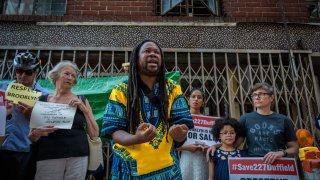
A Brooklyn home linked to the Underground Railroad was given the designation as a historical landmark in an effort to preserve its history.
The building at 227 Duffield Street in downtown Brooklyn was granted landmark status on Tuesday, ending a 16-year battle to stop a developer from turning the building into luxury condos.
The modest brick building, built in the late 1840s, was the home of Harriet and Thomas Truesdell, key figures in the abolitionist movement, first in Rhode Island, and then in Brooklyn, after they moved there in 1851. The borough was a major scene in the abolitionist movement, due to its large ports and waterfront, as well as its sizable population of free African Americans.
"It is fitting that as we begin Black History Month, we are honoring those who fought to save the physical evidence of our history," said NYC first lady Chirlane McCray.
McCray said that those who lived in the home risked a great deal by breaking the law to help others who they had never met, but it was for a greater cause.
"We may not know the names of the African souls that traveled in secrecy and desperation through downtown Brooklyn in search of a better life, but we do know this is one of the many sites that served as a temporary haven as they sought freedom,” said McCray. “We also know that the residents of 227 Duffield Street risked losing power, respect and even their lives by helping those who were fleeing enslavement. These stories of our history need to be celebrated, not erased. It is an honor to highlight these sacred passages of our ancestors.”
U.S. & World
News from around the country and around the globe
Mayor Bill de Blasio was also on hand for the announcement, later saying that the building connects to the city to "a deeper history and something we cannot afford to lose."
New York Attorney General Letitia James, who in 2007 as a New York City Council member helped pass legislation to rename the block "Abolitionist Place" and halted the city from tearing down the structure, cheered the decision to preserve the building. She said that the building "represents one of the most important ties that New York has to our abolitionist roots — roots that every Black New Yorker is proud of."
"During this time of national reckoning over the legacy of slavery and continued injustice faced by Black communities, maintaining that piece of history is critical in remembering how face we've come, and how far we must still go," James said. "This piece of Black New York history will be forever safeguarded so that future generations may know its story."



